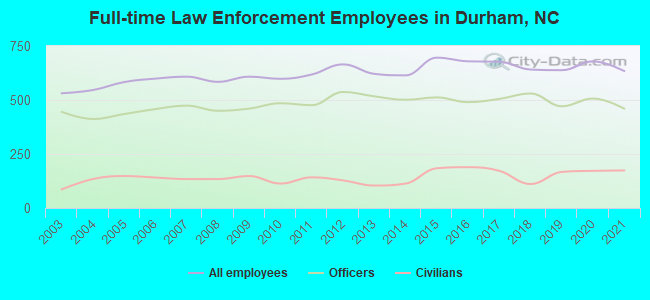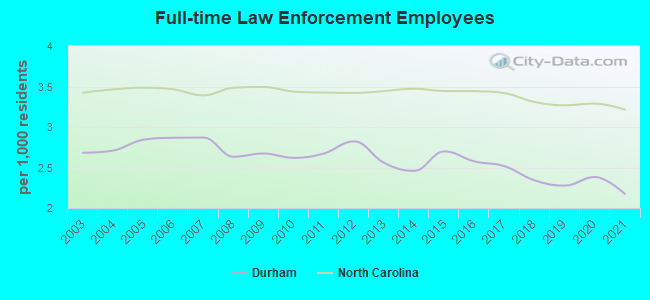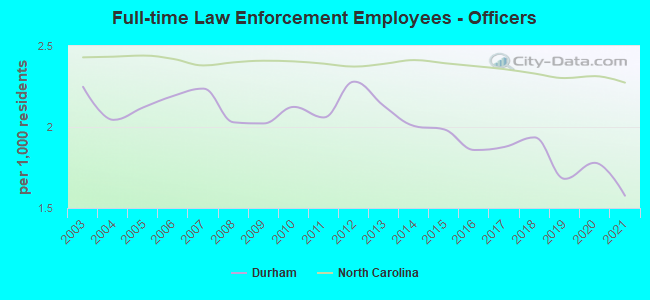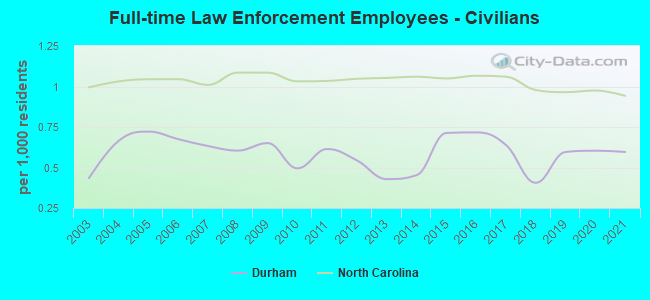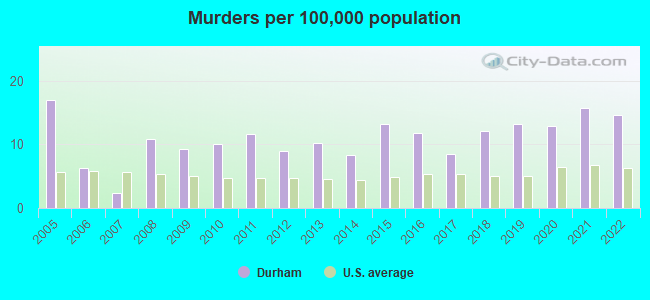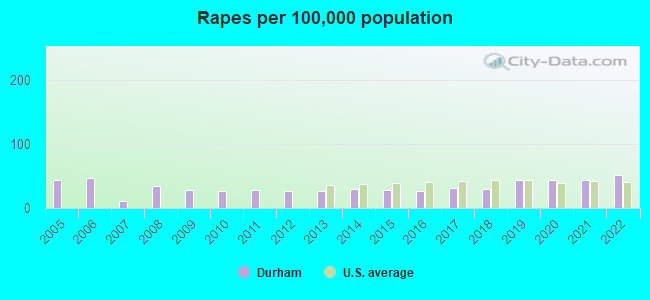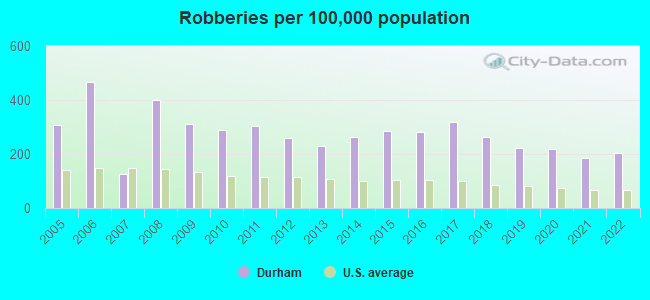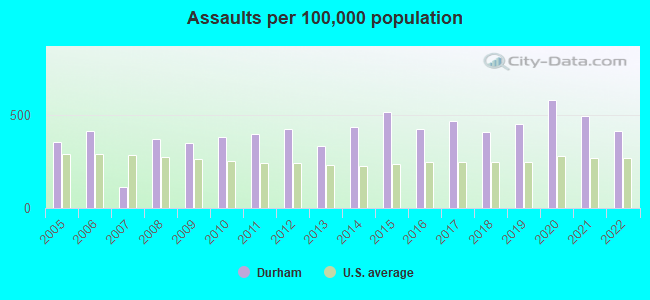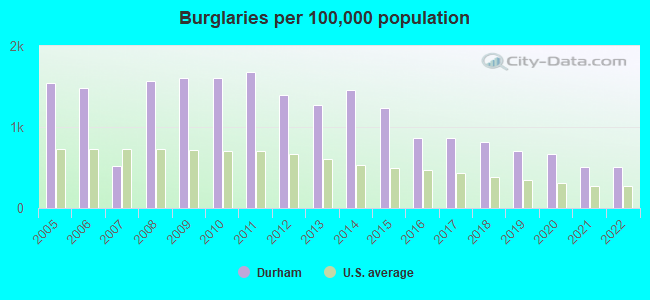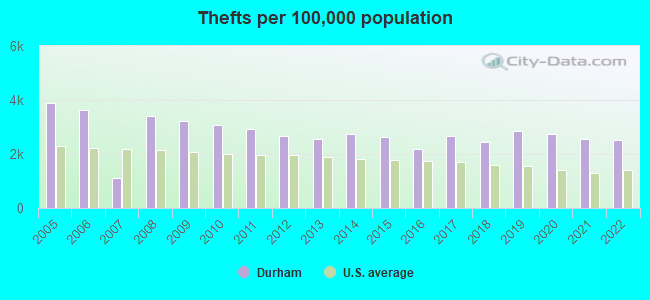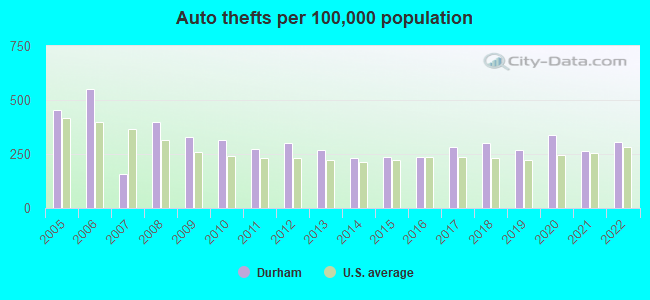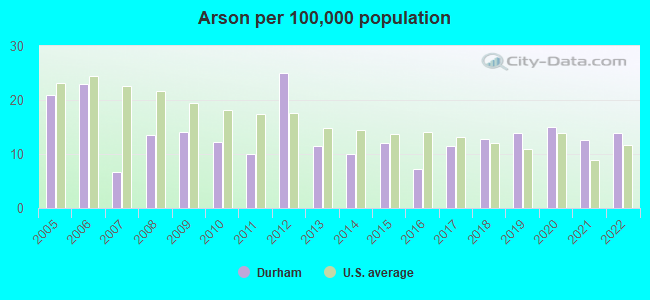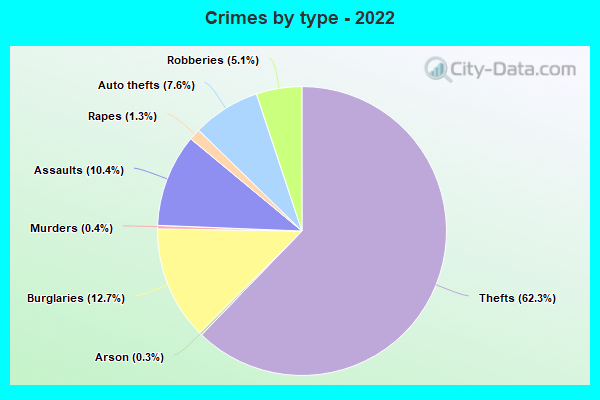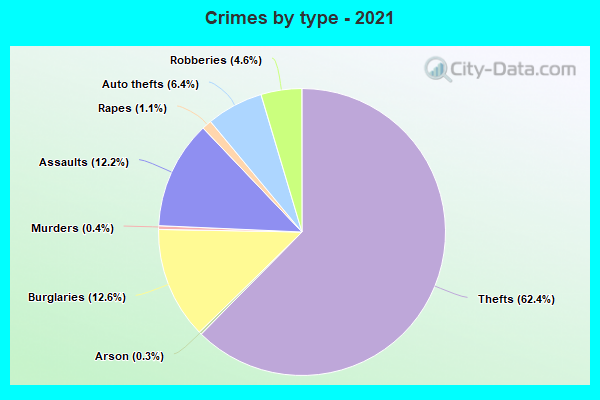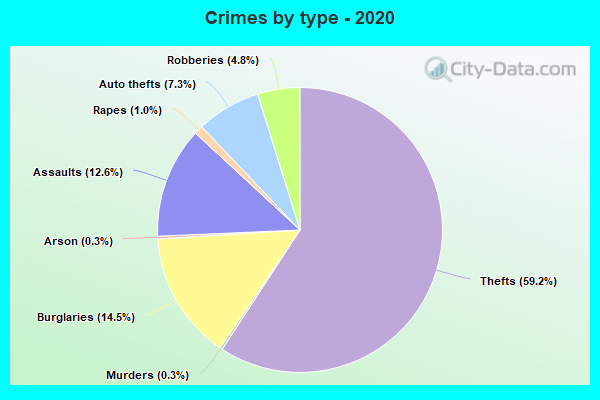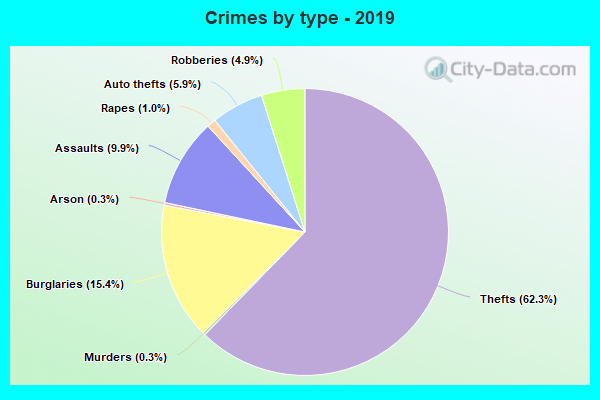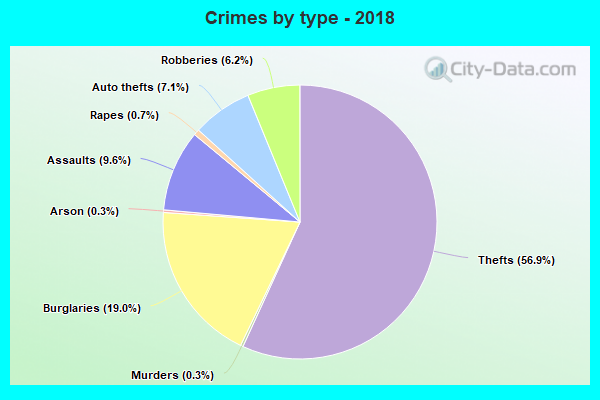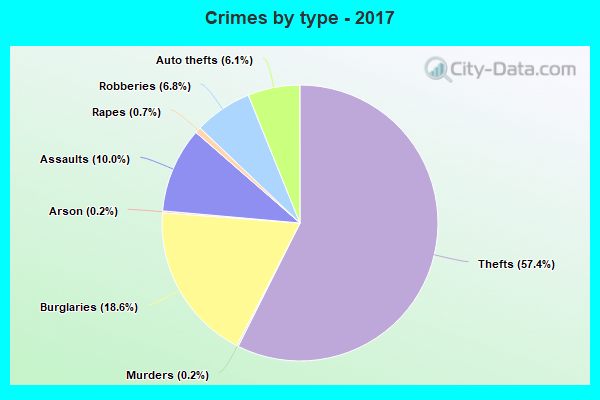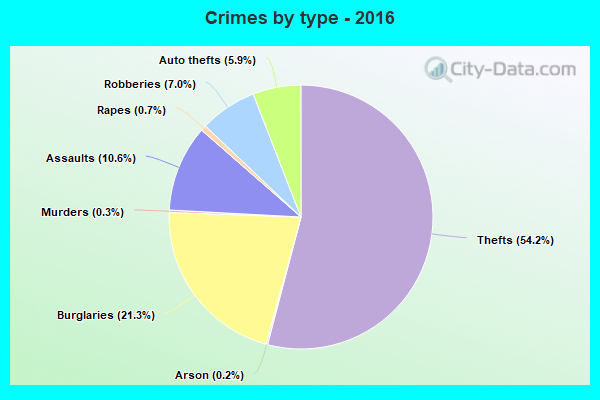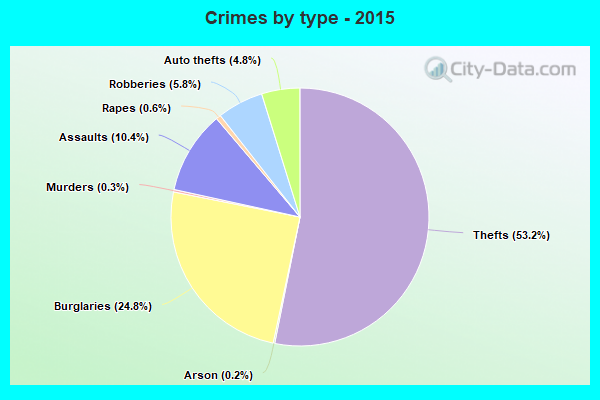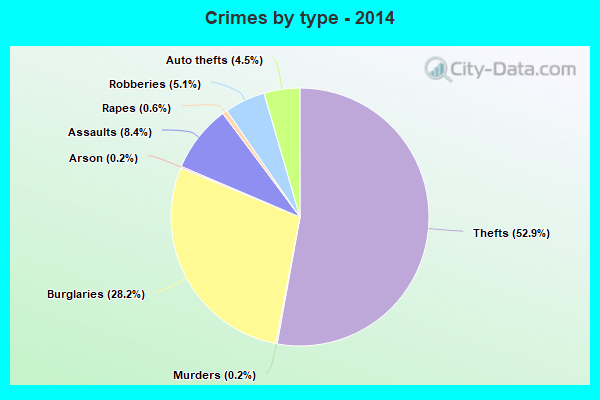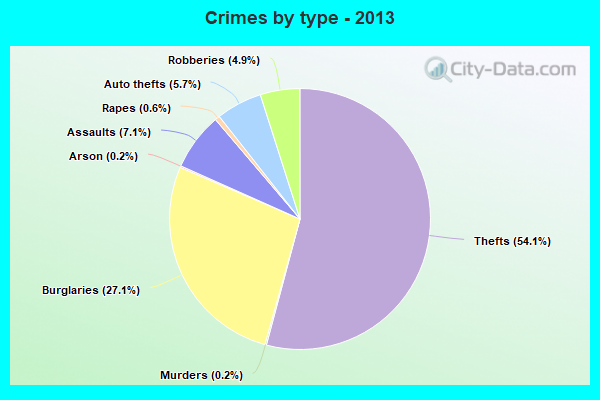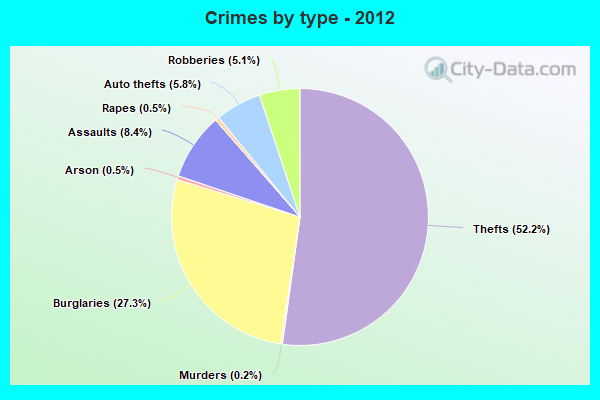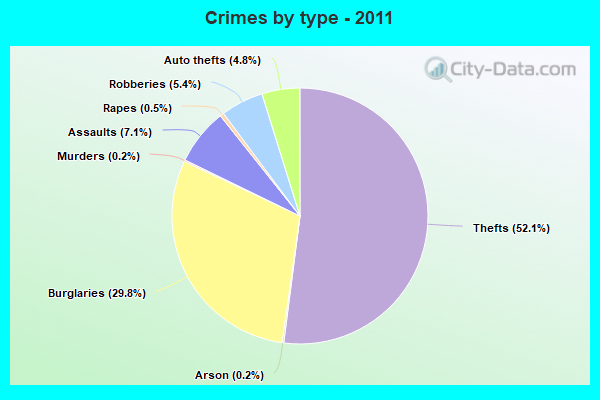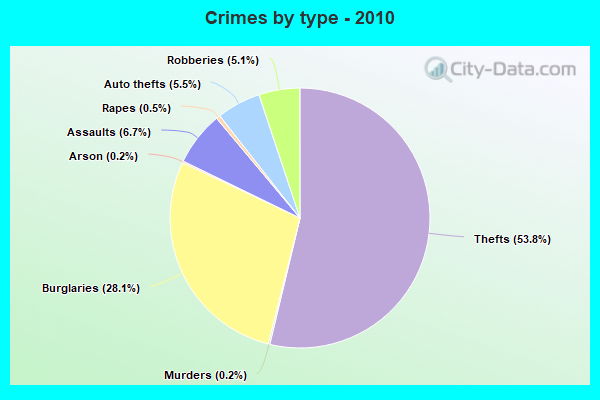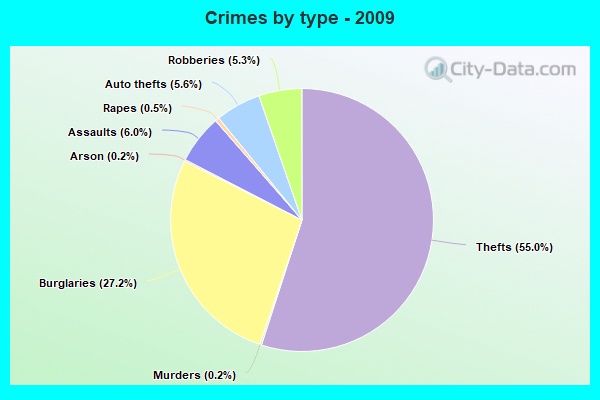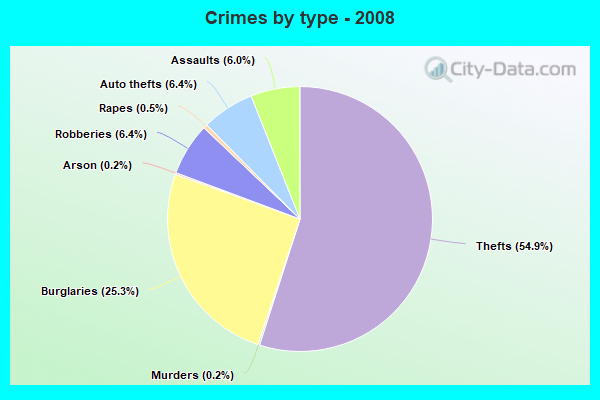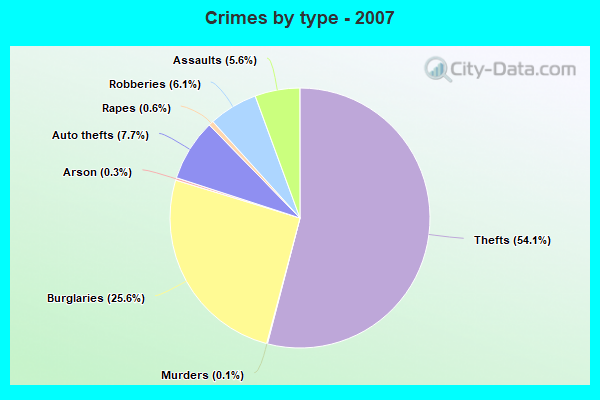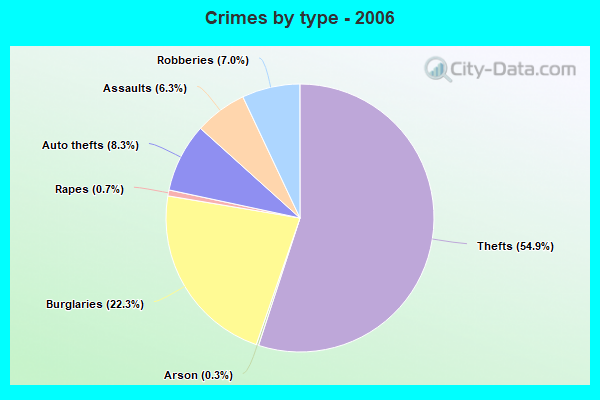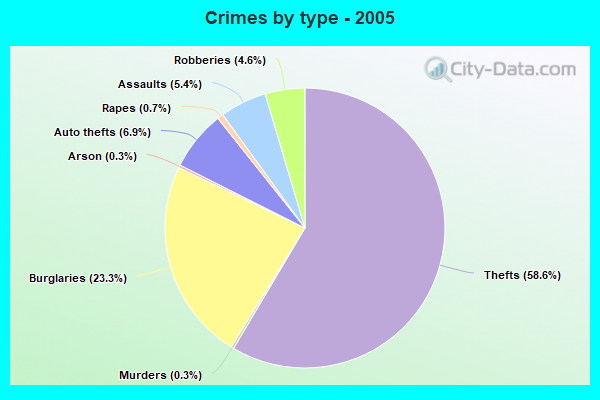Crime rate in Durham, North Carolina (NC): murders, rapes, robberies, assaults, burglaries, thefts, auto thefts, arson, law enforcement employees, police officers, crime map
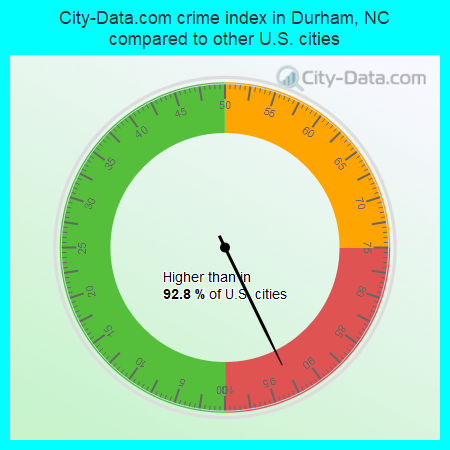
Crime rate in Durham, NC
The 2022 crime rate in Durham, NC is 375 (City-Data.com crime index), which is 1.5 times greater than the U.S. average. It was higher than in 92.8% U.S. cities. The 2022 Durham crime rate fell by 1% compared to 2021. The number of homicides stood at 42 - a decrease of 4 compared to 2021. In the last 5 years Durham has seen decreasing violent crime and decreasing property crime.(Note: Higher means more crime)
| Durham: | 375.1 |
| Chapel Hill: | 149.7 |
| Carrboro: | 166.4 |
| Morrisville: | 135.4 |
| Hillsborough: | 411.8 |
| Butner: | 144.3 |
| Creedmoor: | 210.6 |
| Cary: | 74.0 |
| Apex: | 73.4 |
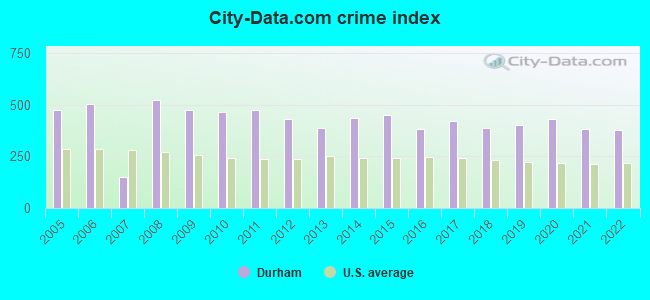
The City-Data.com crime index weighs serious crimes and violent crimes more heavily. Higher means more crime, U.S. average is 246.1. It adjusts for the number of visitors and daily workers commuting into cities.
- means the value is smaller than the state average.- means the value is about the same as the state average.
- means the value is bigger than the state average.
- means the value is much bigger than the state average.
According to our research of North Carolina and other state lists, there were 387 registered sex offenders living in Durham, North Carolina as of April 27, 2024.
The ratio of all residents to sex offenders in Durham is 680 to 1.
The ratio of registered sex offenders to all residents in this city is lower than the state average.
Violent crime rate in 2022
| Durham: | 391.1 |
| U.S. Average: | 219.8 |
Violent crime rate in 2021
| Durham: | 417.2 |
| U.S. Average: | 224.8 |
Violent crime rate in 2020
| Durham: | 471.9 |
| U.S. Average: | 228.2 |
Violent crime rate in 2019
| Durham: | 407.4 |
| U.S. Average: | 219.9 |
Violent crime rate in 2018
| Durham: | 391.6 |
| U.S. Average: | 221.2 |
Violent crime rate in 2017
| Durham: | 439.4 |
| U.S. Average: | 226.2 |
Violent crime rate in 2016
| Durham: | 404.8 |
| U.S. Average: | 227.3 |
Violent crime rate in 2015
| Durham: | 457.7 |
| U.S. Average: | 219.3 |
Violent crime rate in 2014
| Durham: | 394.4 |
| U.S. Average: | 211.1 |
Violent crime rate in 2013
| Durham: | 328.6 |
| U.S. Average: | 214.2 |
Violent crime rate in 2012
| Durham: | 389.7 |
| U.S. Average: | 187.4 |
Violent crime rate in 2011
| Durham: | 400.5 |
| U.S. Average: | 187.1 |
Violent crime rate in 2010
| Durham: | 381.7 |
| U.S. Average: | 195.7 |
Violent crime rate in 2009
| Durham: | 377.4 |
| U.S. Average: | 208.9 |
Violent crime rate in 2008
| Durham: | 442.3 |
| U.S. Average: | 222.5 |
Violent crime rate in 2007
| Durham: | 120.5 |
| U.S. Average: | 229.1 |
Violent crime rate in 2006
| Durham: | 446.4 |
| U.S. Average: | 232.6 |
Violent crime rate in 2005
| Durham: | 362.9 |
| U.S. Average: | 227.0 |
Property crime rate in 2022
| Durham: | 272.8 |
| U.S. Average: | 166.5 |
Property crime rate in 2021
| Durham: | 268.9 |
| U.S. Average: | 157.8 |
Property crime rate in 2020
| Durham: | 321.6 |
| U.S. Average: | 169.6 |
Property crime rate in 2019
| Durham: | 323.1 |
| U.S. Average: | 179.7 |
Property crime rate in 2018
| Durham: | 331.1 |
| U.S. Average: | 190.2 |
Property crime rate in 2017
| Durham: | 349.7 |
| U.S. Average: | 206.4 |
Property crime rate in 2016
| Durham: | 316.6 |
| U.S. Average: | 216.6 |
Property crime rate in 2015
| Durham: | 414.6 |
| U.S. Average: | 221.5 |
Property crime rate in 2014
| Durham: | 464.5 |
| U.S. Average: | 230.8 |
Property crime rate in 2013
| Durham: | 421.6 |
| U.S. Average: | 250.4 |
Property crime rate in 2012
| Durham: | 457.2 |
| U.S. Average: | 267.3 |
Property crime rate in 2011
| Durham: | 522.2 |
| U.S. Average: | 273.5 |
Property crime rate in 2010
| Durham: | 520.1 |
| U.S. Average: | 276.4 |
Property crime rate in 2009
| Durham: | 531.9 |
| U.S. Average: | 285.6 |
Property crime rate in 2008
| Durham: | 545.5 |
| U.S. Average: | 302.2 |
Property crime rate in 2007
| Durham: | 163.7 |
| U.S. Average: | 309.2 |
Property crime rate in 2006
| Durham: | 500.2 |
| U.S. Average: | 317.3 |
Property crime rate in 2005
| Durham: | 507.8 |
| U.S. Average: | 322.3 |
Full-time law enforcement employees in 2021, including police officers: 634 (460 officers - 382 male; 78 female).
| Officers per 1,000 residents here: | 1.58 |
| North Carolina average: | 2.27 |
Full-time law enforcement employees in 2020, including police officers: 679 (507 officers - 426 male; 81 female).
| Officers per 1,000 residents here: | 1.78 |
| North Carolina average: | 2.31 |
Full-time law enforcement employees in 2019, including police officers: 638 (471 officers - 395 male; 76 female).
| Officers per 1,000 residents here: | 1.68 |
| North Carolina average: | 2.30 |
Full-time law enforcement employees in 2018, including police officers: 641 (530 officers - 440 male; 90 female).
| Officers per 1,000 residents here: | 1.94 |
| North Carolina average: | 2.33 |
Full-time law enforcement employees in 2017, including police officers: 677 (505 officers - 424 male; 81 female).
| Officers per 1,000 residents here: | 1.88 |
| North Carolina average: | 2.36 |
Full-time law enforcement employees in 2016, including police officers: 679 (490 officers - 421 male; 69 female).
| Officers per 1,000 residents here: | 1.86 |
| North Carolina average: | 2.38 |
Full-time law enforcement employees in 2015, including police officers: 696 (512 officers - 440 male; 72 female).
| Officers per 1,000 residents here: | 1.99 |
| North Carolina average: | 2.39 |
Full-time law enforcement employees in 2014, including police officers: 614 (501 officers - 425 male; 76 female).
| Officers per 1,000 residents here: | 2.01 |
| North Carolina average: | 2.41 |
Full-time law enforcement employees in 2013, including police officers: 621 (517 officers - 439 male; 78 female).
| Officers per 1,000 residents here: | 2.13 |
| North Carolina average: | 2.39 |
Full-time law enforcement employees in 2012, including police officers: 665 (537 officers - 451 male; 86 female).
| Officers per 1,000 residents here: | 2.28 |
| North Carolina average: | 2.37 |
Full-time law enforcement employees in 2011, including police officers: 618 (476 officers - 406 male; 70 female).
| Officers per 1,000 residents here: | 2.06 |
| North Carolina average: | 2.39 |
Full-time law enforcement employees in 2010, including police officers: 598 (485 officers - 417 male; 68 female).
| Officers per 1,000 residents here: | 2.12 |
| North Carolina average: | 2.40 |
Full-time law enforcement employees in 2009, including police officers: 608 (460 officers - 392 male; 68 female).
| Officers per 1,000 residents here: | 2.02 |
| North Carolina average: | 2.41 |
Full-time law enforcement employees in 2008, including police officers: 584 (450 officers - 384 male; 66 female).
| Officers per 1,000 residents here: | 2.03 |
| North Carolina average: | 2.40 |
Full-time law enforcement employees in 2007, including police officers: 608 (474 officers - 406 male; 68 female).
| Officers per 1,000 residents here: | 2.24 |
| North Carolina average: | 2.38 |
Full-time law enforcement employees in 2006, including police officers: 599 (458 officers - 389 male; 69 female).
| Officers per 1,000 residents here: | 2.19 |
| North Carolina average: | 2.42 |
Full-time law enforcement employees in 2005, including police officers: 583 (435 officers - 377 male; 58 female).
| Officers per 1,000 residents here: | 2.12 |
| North Carolina average: | 2.44 |
Full-time law enforcement employees in 2004, including police officers: 546 (412 officers - 356 male; 56 female).
| Officers per 1,000 residents here: | 2.04 |
| North Carolina average: | 2.43 |
Full-time law enforcement employees in 2003, including police officers: 531 (445 officers - 384 male; 61 female).
| Officers per 1,000 residents here: | 2.25 |
| North Carolina average: | 2.43 |
